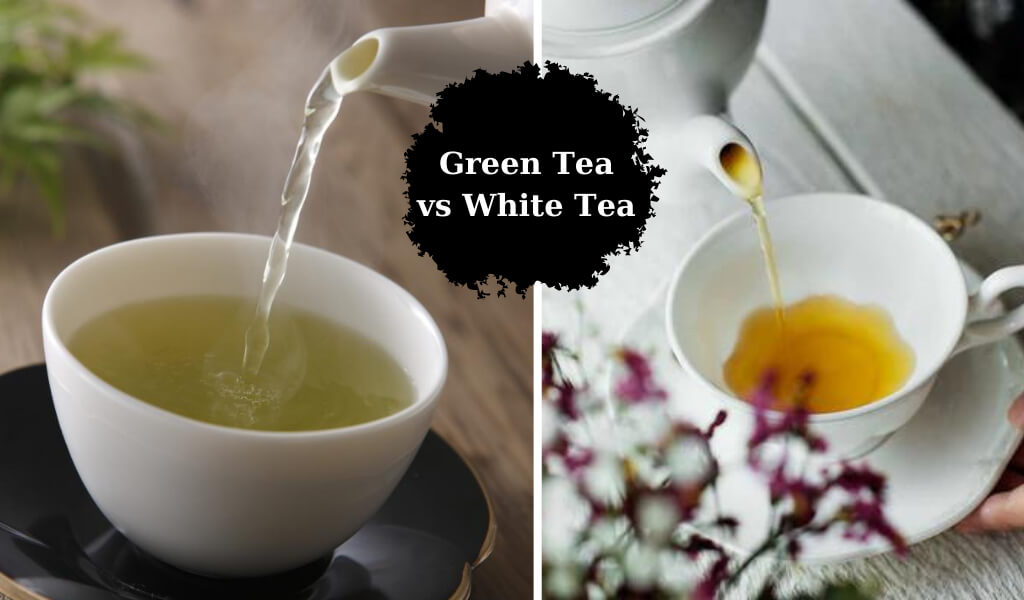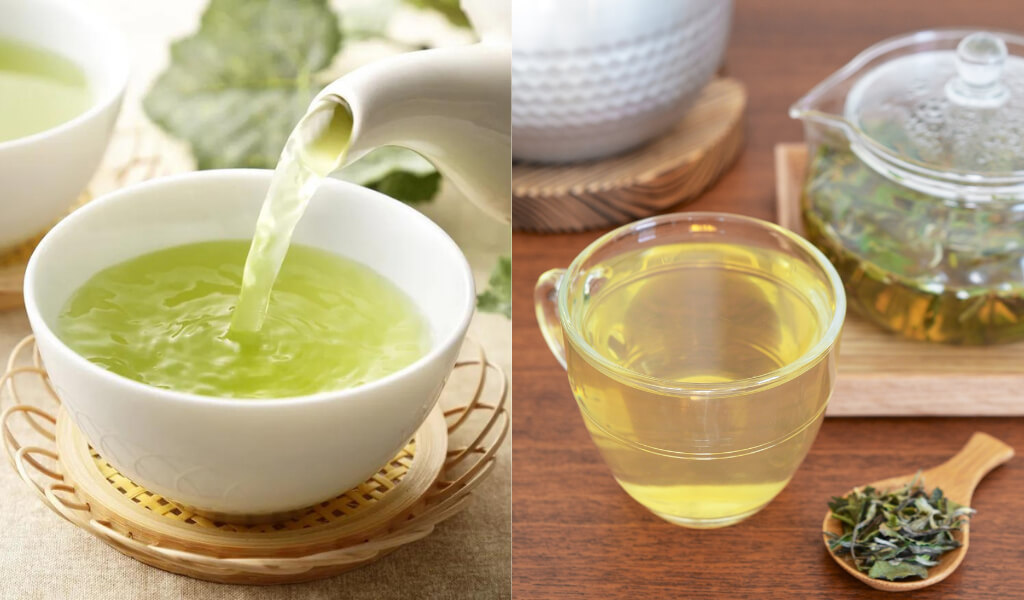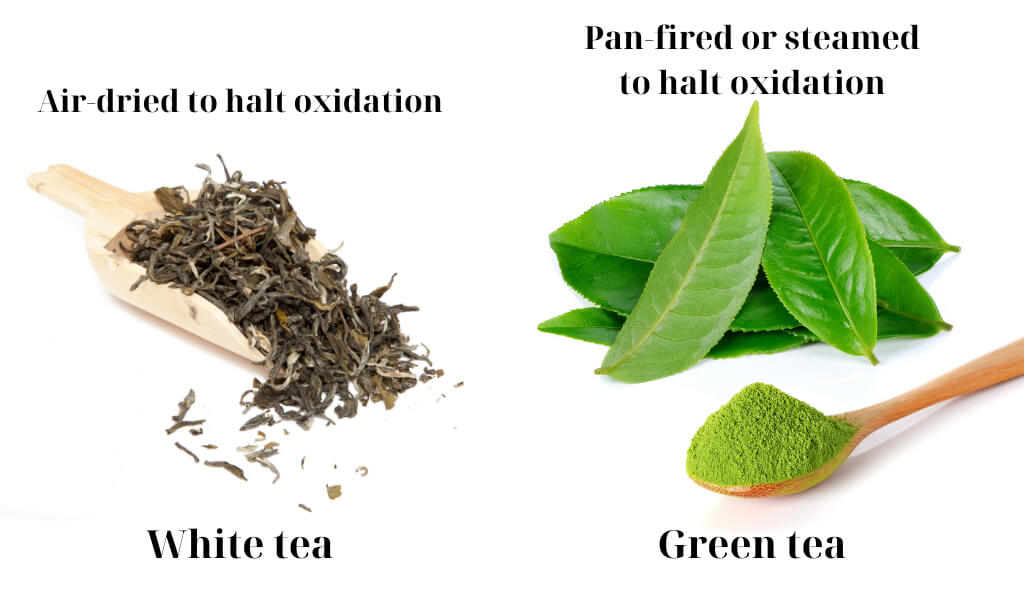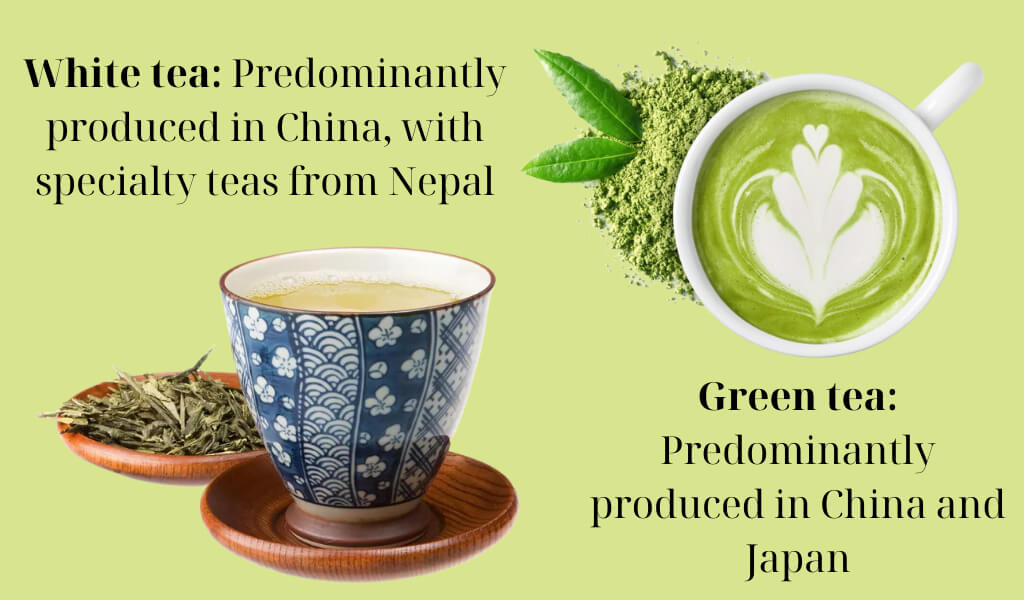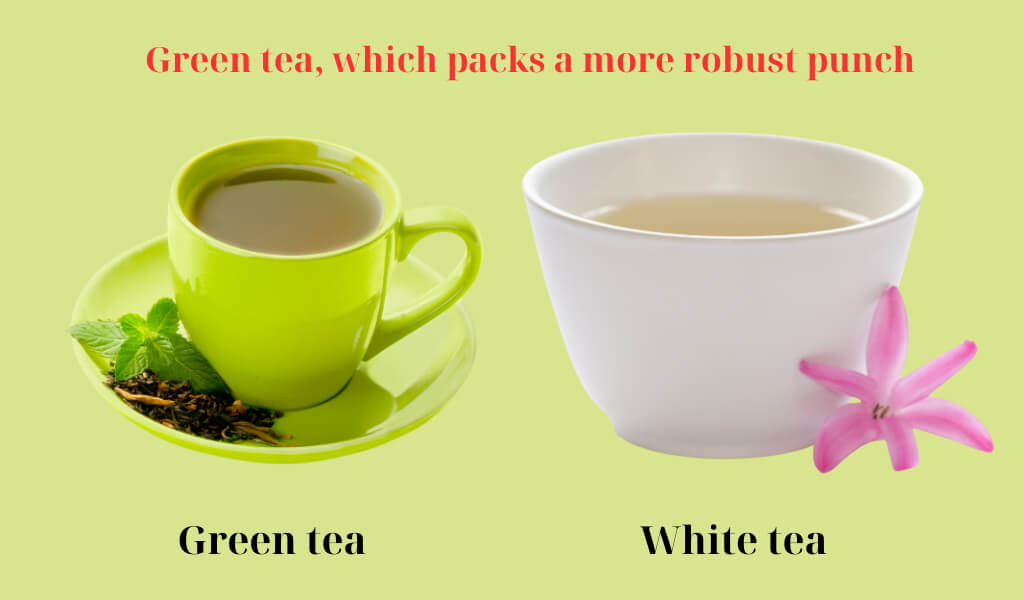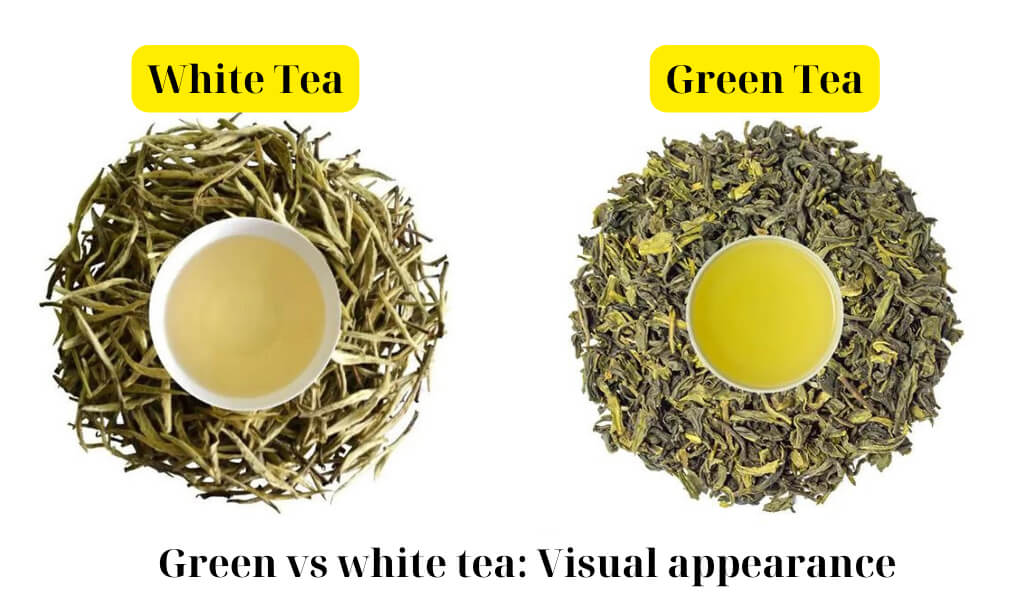The debate of “white tea vs green tea” is ongoing; today, I’m here to shed some light on it.
Each has unique characteristics that make them special, and understanding these differences can help enhance your tea-drinking experience.
Read More:
- Black Tea vs Green Tea: Some tips from tea Connoisseurs
- Benefits of Oong Tea vs Green Tea: What are the main difference?
- Green Tea vs Pu erh tea: Benefits, Nutrition, Process and More
So, let’s embark on this journey together to explore and appreciate the subtleties these two wonderful teas offer.
Quotes of tea with You
“Anyone who has used that comforting phrase ‘a nice cup of tea’ invariably means Indian tea.”
– George Orwell, A Nice Cup Of Tea
White Tea vs Green Tea: The Basics
Understanding the basics of Green tea and White tea, I think it’s best to start from their origins and characteristics.
Green Tea – The Jade Elixir
Green tea is made from Camellia sinensis leaves and buds, which haven’t undergone the same withering and oxidation process used to make Oolong and Black teas.
The tea plants are native to East Asia, probably originating in the borderlands of north Burma and southwestern China. To produce green tea leaves from the plant are steamed, pan-fried, and dried, giving it a distinctive taste and aroma.
Most green tea is produced from the China plant and is grown predominantly in Japan, China, and to some extent, Malaysia and Indonesia. The Chinese style of green tea is characterized by pan firing, where tea leaves are heated in a basket, pan, or mechanized rotating drum to halt the oxidation process.
Chinese green teas may be fired more than once during processing, depending on the style of tea being produced.
White Tea – The Emperor’s Brew
White tea may have first appeared in English publication in 1876 and was initially categorized as black tea because the leaves are not steamed first as in the making of green tea6.
This tea comprises young, springtime tea leaves traditionally grown in China’s Fujian province. Dried tea is known for its small, withered leaves and slightly fuzzy buds. When brewed, it is typically light gold with a floral fragrance.
White tea traces its roots back to the Fujian province in China, where it has been produced for over a thousand years. This region is known for its misty mountains and fertile soil, providing the perfect environment for the Camellia sinensis plant to thrive8.
White tea undergoes the least amount of processing, which contributes to its delicate taste and higher concentrations of EGCG, a major constituent of tea catechins, compared to green tea.
Historically, the process of white tea goes as far back as the Shang Dynasty of China (1766 BC – 1050 BC), where tea leaves were air dried and then typically added to a boiling pot full of water, herbs, and spices to create a blend used for medicinal purposes.
White tea was discovered during the Song Dynasty in China between 960 and 1279 AD. During this period, the Chinese discovered that the youngest buds would produce a more mild tasting and refreshing tea, known as the Emperor’s drink.
Here’s a quick comparison chart between White Tea vs Green Tea:
| Criterion | Green Tea | White Tea |
| Plant Origin | Camellia Sinensis | Camellia Sinensis |
| Processing | Pan-fired or steamed to halt oxidation | Air-dried to halt oxidation |
| Antioxidant Content | High (polyphenols) | High (polyphenols) |
| Country of Origin | Predominantly produced in China and Japan |
Predominantly produced in China, with specialty teas from Nepal
|
| Taste | Nutty, grassy, and vegetal notes | Mild, with delicate hints of apple and hay |
| Visual Appearance of Leaves | Usually pressed into needle-like shapes or curled, green in color |
Full-leaf or silver needle white tea, white, brown, or light green-colored leaves
|
| Health Benefits | Anti-aging, anti-cancer, anti-inflammatory effects, sterilization properties |
Boosts immunity, safeguards cardiovascular system, aids in blood sugar balance
|
| Preparation Temperature | Traditionally steeped in slightly hotter water, around 160-180°F (70-85°C) |
Steeped in water around 175°F (80°C) to preserve subtle flavors
|
| Nutritional Differences | Contains less theanine and vitamin A compared to white tea |
Contains more theanine and vitamin A compared to green tea
|
| Appearance After Brew | Shapes can be flat, spiral, or curly, clear green soup |
Silvery-white hair color, intact bud hairs, fat bud head, clear yellow-green tea
|
| Brew Color | Can range from a deep emerald shade to a pale yellowish-green tone | Light, gold-colored liqueur |
| Caffeine Content | Depending on various factors, it can be lower or higher than white tea |
Depending on various factors can be lower or higher than green tea
|
Similarities Between Green Tea vs White Tea
Both come from the same plant, Camellia Sinensis and boast an array of impressive health benefits, largely thanks to their high antioxidant content.
In terms of processing, both teas are carefully crafted to preserve their unique qualities. Green tea leaves are usually pan-fried or steamed to halt oxidation, while white tea leaves are air-dried for the same purpose. This careful attention to detail during processing brings out the distinctive characteristics we love in both teas.
Speaking of antioxidants, both green and white tea are packed with them! They contain a group of antioxidants known as polyphenols, which provide a multitude of health benefits, including potential protection against various diseases.
Difference between White Tea vs Green Tea
Now, let’s explore the notable differences between these two teas.
White vs green tea: Country of origin
China’s heartland of white tea production is its perfect climate and centuries-old tea traditions. On the other hand, green tea is predominantly produced in China and Japan, both countries with a rich tea cultivation history.
Now, let’s delve a bit deeper. While China takes the lead in producing white tea, some fantastic specialty white teas come from Nepal’s rugged landscapes. The Nepalese take great pride in their tea production, creating unique flavors.
As for green tea, China and Japan are the key players. But the story doesn’t end there – green tea is also crafted in other Asian countries, each adding its unique touch to the green tea we know and love.
It’s worth noting that the places of origin for these teas – China, Japan, and Nepal – aren’t just geographical locations. They are significant entities that contribute to the unique qualities of white and green tea, from the cultivation techniques to the local climate and soil conditions. These elements play a huge role in the tea’s taste, aroma, and overall quality.
Green Tea vs White Tea Taste
White tea is often beautifully mild, with delicate hints of apple and hay that dance on your tongue. Contrast that with green tea, which packs a more robust punch. Its flavors are a medley of nutty, grassy, and vegetal notes that make every sip an adventure.
Green vs white tea: Visual appearance
When it comes to white teas, I notice that they come in two different appearances. The first is full-leaf white tea, which looks like actual leaves. The second is silver-needle white tea, which features downy, white-tipped buds.
These teas can have white, brown, or light green-colored leaves. When brewed, white teas produce a light, gold-colored liqueur.
As for green teas, they are usually pressed into needle-like shapes or curled during the drying process. Just as their name suggests, green tea leaves are typically green. When brewed, green teas can range from a deep emerald shade to a pale yellowish-green tone.
Difference between white tea and green tea: Distinguishing Features
I notice how green tea maintains many natural components from the fresh leaves. It retains over 85% of tea polyphenols and caffeine, about 50% chlorophyll, and minimizes vitamin loss.
This gives green tea its unique clear, astringent taste and bright green leaves.
Numerous scientific studies underline the health benefits of green tea, such as its anti-aging, anti-cancer, and anti-inflammatory effects and its sterilization properties, which many other teas can’t match.
On the other hand, white tea is admired for its silvery white hairs on the buds, giving it the aesthetic of “green makeup”. The buds are robust and large, the tea appears bright yellow, the flavor is fresh and smooth, and the leaves are tender and uniform.
After brewing, the taste is deliciously mellow, and this tea has its own medicinal properties too. Traditional Chinese medicine credits white tea for its cooling nature and ability to reduce fever.
Among its many varieties, like Yinzhen, Baimudan, Gongmei, and Shoumei, the Baihao Yinzhen stands out. With its white, needle-like buds, this tea variety is one of the most stunning, producing a light yellow, refreshing brew that lingers in your memory.
White tea versus green tea: Nutritional Differences
Due to these different production processes, white and green tea retains different leaf components. Green tea, being unfermented, and white tea, being only slightly fermented, have slight differences in the content of tea polyphenols.
White tea retains a large amount of theanine due to not undergoing a high-temperature process, while green tea’s theanine content is reduced. Both teas contain equal amounts of caffeine, but theanine in white tea can neutralize caffeine, reducing its stimulation.
Furthermore, research shows that white tea has higher vitamin A and flavonoid levels than green tea.
White tea vs green tea benefits
So, green tea vs white tea health benefits, which one is better? Comparatively, white tea boasts higher tea polyphenols than green and oolong teas. These natural antioxidants can boost immunity and safeguard the cardiovascular system.
Additionally, white tea contains active enzymes that our bodies need, promoting fat catabolism, controlling insulin secretion, breaking down excess blood sugar, and aiding in blood sugar balance. Truly, it’s a beautiful gift for health and beauty.
White tea benefits vs green tea: Preparation
Preparation-wise, white tea is simpler to make than black and green teas.
To preserve its subtle flavors, white tea is often enjoyed by steeping the delicate leaves in water that’s not too hot, typically around 175°F (80°C). Green tea is traditionally steeped in slightly hotter water, around 160-180°F (70-85°C), to bring out its unique characteristics.
White tea vs oolong tea: Appearance
Key features of white tea include a silvery-white hair color, intact bud hairs, a fat bud head, clear yellow-green tea, and tender, even leaf bottoms.
The shapes of green teas can be fascinating: flat green tea such as Longjing tea, Qiandao jade leaf, and Que tongue tea; spiral-shaped green tea like Biluochun and Cuiluo; and curly green tea like Duyun Maojian and Takahashi Yinfeng.
Color of Brew
The white tea brew or ‘soup’ is typically clear and bright. New green tea, in contrast, gives a clear green soup that may turn slightly yellow over time. When stored at room temperature, green tea can oxidize easily, changing darker colors from light yellow to dark yellow.
White tea vs green tea caffeine
White tea has the least caffeine among all true teas, typically ranging from 15 to 20 milligrams per cup. Green tea has a bit more caffeine than white tea but less than black tea, with 35 to 70 milligrams per serving.
The amount of caffeine in tea depends on various factors, such as the type of tea and the way it’s grown, harvested, and processed. Even the way you brew your tea can affect its caffeine content.
I can’t tell you exactly how much caffeine your cup of tea will have, but you can make an educated guess by looking at the tea leaves. Generally, teas made from younger leaves tend to have more caffeine compared to teas made from older, larger leaves. Tea harvested in the spring and summer usually contains more caffeine than autumn teas. If you use broken leaves or tea dust, your cup will likely have a higher caffeine content too.
Some studies have found that certain white teas, like Silver Needle and White Peony, may have more caffeine than many green teas.
Additionally, Japanese-shaded green teas like Gyokuro can also have higher caffeine levels compared to white tea and other green teas.
One Polish study discovered that white teas contained an average of 28.584 mg of caffeine per 100 ml, while green tea had about 26.445 mg per 100 ml. This study used 1 gram of tea leaves steeped for 5 minutes at 212°F.
However, it’s important to note that even if you use more tea leaves per cup of water, you should avoid using boiling water for white or green tea. By using slightly cooler water, the caffeine content in the tea you brew at home will be lower than in the study mentioned earlier.
White and green tea generally have lower caffeine levels than other caffeinated beverages. For instance, an average cup of coffee contains around 100 mg of caffeine, although the actual amount can vary. Some large cups of coffee sold in coffee shops can even exceed 300 mg of caffeine per serving. So, if you’re looking for a milder dose of caffeine, white tea and green tea are good options to consider.
Green tea vs white tea weight loss
So, white tea vs green tea weight loss: which is better? The comparison between white tea and green tea in terms of their effects on weight loss. There need to be more credible studies that directly compare these two types of tea. White tea may have an edge due to its higher polyphenol content, given it undergoes less processing than black tea and isn’t pan-fried like green tea. However, these differences are rather minute.
Why, you ask? Because whether it’s white, green, or any other type of leaf tea, they all originate from the same plant – the Camellia sinensis. So, while we can certainly get into the nitty-gritty details, sipping on any teas from the Camellia sinensis plant can be a delightful and healthy addition to your weight loss journey.
White tea vs green tea for skin
While white and green tea offer numerous skin benefits, they each have unique strengths. Here’s a comparison:
White Tea for Skin – Score: 8/10
White tea holds an impressive array of benefits for the skin, earning it a high score.
- Anti-Aging Properties (9/10): White tea’s rich antioxidant content helps combat oxidative stress, a key factor in skin aging.
- Skin Soothing (8/10): Its inherent cooling nature is excellent for reducing skin inflammation and redness.
- Skin Rejuvenation (7/10): Some research suggests that white tea may promote skin cell renewal, although more studies are needed to confirm this.
Green Tea for Skin – Score: 9/10
Green tea scores slightly higher for skin benefits, thanks to its potent antioxidants and anti-inflammatory properties.
- Sun Damage Protection (9/10): Green tea’s high levels of EGCG provide substantial protection against UV damage, helping to prevent sun-induced skin aging.
- Acne Control (9/10): Green tea’s anti-inflammatory properties can effectively reduce acne and other skin inflammations.
- Skin Elasticity Improvement (8/10): Green tea is associated with improved skin elasticity and the reduction of wrinkles. More comprehensive research is still needed in this area, but current studies are promising.
Overall, both teas have great benefits for the skin, but your personal needs and skin condition should guide your choice. Whether it’s the cooling, rejuvenating effects of white tea or the sun protection and acne-control properties of green tea, both can be excellent additions to your skincare routine.
Who Should Drink White Tea or Green Tea (And Why)?
So, between white tea vs green tea, which one should you choose and why? Here are the detailed explain for you:
Green Tea Drinkers
You might prefer green tea if:
- You enjoy a robust flavor profile.
- You prefer a clear, astringent taste. Green tea’s bright leaves and unique flavor could be a great fit.
- Green tea maintains over 85% of tea polyphenols and caffeine.
White Tea Drinkers
You might favor white tea if:
- You favor a mild, mellow flavor.
- You seek traditional medicinal benefits. White tea is associated with cooling properties and the ability to reduce fever in traditional Chinese medicine.
- White tea promotes fat catabolism and helps balance blood sugar.
- You appreciate the aesthetics of tea.
The comparison was done by Shanna Smith of Spiritea Drinks.
FAQs
Which tea is milder: green tea or white tea?
White tea is generally considered milder than green tea. It has a lighter, more subtle flavor profile, often with a sweet undertone. Green tea, on the other hand, can be more robust and astringent, with complex notes of grassiness, vegetables, and, sometimes, a slightly bitter finish.
Which countries are known for their green and white tea production?
China and Japan are key players in green tea production, while China leads in white tea production. Nepalese white teas also have a growing reputation for their fine quality. Different regions offer distinctive variations in flavor profiles, reflecting their unique terroir.
Can I drink green tea and white tea daily?
Yes, both green tea and white tea can be consumed daily. These teas are naturally low in calories and rich in beneficial compounds, making them a healthy addition to a balanced diet. As with anything, moderation is key – too much can lead to excessive caffeine intake or stomach upset.
Is there the best time to drink white tea vs green tea?
The best time to drink white or green tea depends on individual preferences and how your body reacts to caffeine. Some people enjoy these teas in the morning for a gentle caffeine boost, while others prefer them for a little pick-me-up in the afternoon. Since white tea can sometimes have more caffeine, avoiding it close to bedtime might be better if you’re sensitive to caffeine.
Which tea is more popular worldwide: white tea or green tea?
While both teas have their fans, green tea is generally more popular and widely consumed worldwide. This might be due to its broader range of flavors, long history, or more extensive marketing. However, white tea is gaining popularity for its delicate flavors and perceived health benefits.
How should I store green tea and white tea to maintain their freshness?
Both green and white teas should be stored in a cool, dark place, away from light, moisture, and strong odors. Ideally, they should be consumed within a year of purchase to enjoy their best flavors and health benefits. A well-sealed, opaque container is best for storing these delicate teas.
Can I cold brew white tea and green tea?
Both white tea and green tea are excellent for cold brewing. Cold brewing can bring out different flavor notes, resulting in a smoother, less astringent taste. Adjust the steeping time, as cold brewing usually takes longer than hot brewing.
Reference source:
Green and white teas as health-promoting foods – https://pubs.rsc.org/en/content/articlehtml/2021/fo/d1fo00261a
Healthy properties of green and white teas – https://pubmed.ncbi.nlm.nih.gov/28640307/
I’m Shanna, creator of Spiritea Drinks. I’m all about teaching people to grow their own food, tea, cook what they harvest, and eat with the seasons.

